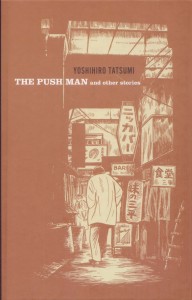Ryan Holmberg has left a bunch of interesting comments on Suat’s essay about Tatsumi. I thought I’d highlight some of them here.
I realize I am commenting on a two-month old post, but I just now read it.
I agree with the basic crux of this analysis of Tatsumi. I think it is harsh but fair when it comes to metaphor and sexual values. In that era of Tatsumi’s work every oblong is a phallus and every hole a vagina, no doubt, and the misogyny is unmistakable.
Given this – given that Tatsumi’s work is unsubtle – I have to say your review is about as obvious as Tatsumi’s work. I sympathize with the desire to serve up a corrective to the promotional garbage that fills the press, but you are fighting straw men. I am not sure if you are saying much more than what any of us who have had doubts about Tatsumi’s glory have thought at one time or the other.
You were fairly generous about the menstrual flowers in Tsuge’s Red Flowers. Why is it that clichéd sexual euphemisms are okay in a pastoral “literary” genre but not in pulp? Is the problem that the cicadas and babbling brooks are peeled away?
Also, on what basis are Tatsumi’s drawings “crude” and “inept”? For the most part (some exceptions), they seem pretty finished to me, and work perfectly well for what he was trying to do. “Unpolished skills?” He was a 15-year veteran in 1970.
“A failure to move beyond what remains totally acceptable in modern day manga”? You mean manga then? If so, tell me who was doing stories like Tatsumi’s in 1970, aside from Tsuge. Second, Tatsumi was black-listed by Shonen Magazine, supposedly (according to Tatsumi in “Gekiga kurashi”) after their print-run fell after publishing one of his works) – clearly he was not “totally acceptable.”
Also, “Tatsumi was no different from those individuals (the factory mangaka)”? Just on the basis of a lack of character types? I think you also mention pressing deadlines as a reason for how the work looks the way it does. I doubt it. At this point, he was writing for very few weeklies (this changes in the mid 70s, after the period in question). An artist like him with a 15 year career, having produced hundreds of pages a month for many years, do you think writing one 20 page story per month was rush work? At least be generous enough to assume that the artist knew what he was doing and had complete control over the product. He might not have been a poet or a Kojima Goseki-caliber draftsman, but he was also not an amateur.
Again, I sympathize with your basic distaste. But not with the venting.
And here’s a follow up.
The difference in finish between Projectionist and Forked Road is obvious, and as you pointed out it probably has something to do with Tatsumi`s circumstances at the end of the 60s. (Side note: your quote about Tatsumi having a bunch of artists working for him…I think that means artists writing comics for the magazine-anthologies he was publishing, not assistants for his own work…but I will have to check this.) But first of all Projectionist-type crude drawing has a long tradition in kashihon comics in Japan (this is the point where is moving from kashihon to magazines), so I don`t think it can be chalked up to lack of time or skill, and the increase in finish over those two years also has to do with the different standards of the manga monthlies and weeklies, not just a personal aesthetic decision on Tatsumi`s part. That doesnt make the work better or worse, but I think one should, especially when critiquing an artist so harshly, have some consideration for context.
Just quickly, on Imamura, I haven’t watched these in years, but the Pornographers maybe, Insect Woman, Ningen johatsu (probably not in English). They are much more humorous than Tatsumi, but there is some overlapping setting and gender views. The impact of Nikkatsu films is also big on all of the Gekiga artists, from the Action stuff to the romantic stuff. To me, Tatsumi belongs in that world.
As for Tatsumi’s busy schedule in the late 60s, when he started doing those dirty-men stories. His prose (versus manga) autobiography “Gekiga kurashi,” published last year, has a bit on this period. It says in short, the mid 60s were a difficult time. Then an editor from a second-tier magazine name Gekiga Young commissioned 2 x 8 pages a month from him, which he claims was hard work given his publishing venture. The editor apparently requested lots of revisions, less speech balloons, etc for a tighter more visual product. I would have to check, but these are probably the short works in Pushman. He also thanks the editor for getting him inspired about making manga again.
Later, he talks about how he had a long standing feeling against using assistants, arguing that one’s work should be one’s own. He says that in 1974 he had to swallow his pride and hire two assistants to complete a commission from Shukan Manga Sunday (a weekly). I will have to do more poking around, but the way things are worded here is that this was a turning point in the way he made comics. Maybe at the height of his popularity in the late 50s he had assistants, but given the economic difficulties of kashihon publishing in the mid 60s, I doubt he had them then.
Do click through the links, as there are additional remarks by Ryan, and comments by Suat and others.
